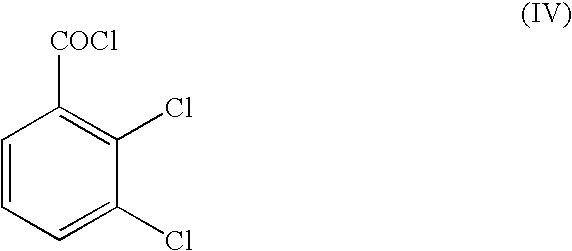Method for preparing lamortrigine and its intermediate 2,3-dichlorobenzoyl chloride
a technology of lamortrigine and benzoyl chloride, which is applied in the field of lamortrigine and the intermediate 2,3-dichlorobenzoyl chloride, can solve the problems of serious side effects in patients, and achieve the effects of low impurity amount, high purity, and high purity
- Summary
- Abstract
- Description
- Claims
- Application Information
AI Technical Summary
Benefits of technology
Problems solved by technology
Method used
Image
Examples
example 1
Synthesis of 2,3-dichlorobenzotrichloride
[0065]A UV photochlorination reactor was loaded with 245 g of 2,3-dichlorotoluene (1.52 moles) and 1225 g of CCl4. The reactor was heated to 75° C. and chlorine was introduced at a flow of 190 g / h. At the end of the reaction, the flow is decreased to minimize break-through of chlorine. The crude mixture was analyzed showing a content of 2,3-dichlorobenzal chloride 4 was distilled from the reaction mixture at 600 to 800 mbar. The crude product was then let to distil at 13 mbar and 128° C. giving 334.2 g of 2,3-dichlorobenzotrichloride with a GC assay of 98.2%. Yield was 81.6%.
example 2
Synthesis of 2,3-dichlorobenzoyl chloride
[0066]A reactor was loaded with 168.9 g of 2,3-dichlorobenzotrichloride (assay 98.9%, 0.63 moles). The product was heated to 100° C. and a catalytic amount of ZnCl2 (0.2 g) was added. The mixture was further heated to 160° C. To the reactor was added dropwise 12.0 g of water while keeping temperature at 160° C. Addition time was 7 hours. The crude product was then let to distil giving 120.5 g of 2,3-dichlorobenzoyl chloride with a GC assay of 99.7%. Yield was 91.0%.
example 3
Synthesis of 2,3-dichlorobenzotrichloride
[0067]A UV photochlorination reactor was loaded with 220.5 g of 2,3-dichlorotoluene (1.37 moles) and 1584 g of CCl4. The reactor was heated to 75° C. and chlorine was introduced at a flow of 190 g / h. At the end of the reaction, the flow was decreased to minimize break-through of chlorine. The crude mixture was analyzed showing a content of 2,3-dichlorobenzal chloride 4. The crude 2,3-dichlorobenzotrichloride (366.5 g) had a GC assay of 96.0%. Yield was 97.1
PUM
| Property | Measurement | Unit |
|---|---|---|
| temperature | aaaaa | aaaaa |
| temperature | aaaaa | aaaaa |
| temperature | aaaaa | aaaaa |
Abstract
Description
Claims
Application Information
 Login to View More
Login to View More - R&D
- Intellectual Property
- Life Sciences
- Materials
- Tech Scout
- Unparalleled Data Quality
- Higher Quality Content
- 60% Fewer Hallucinations
Browse by: Latest US Patents, China's latest patents, Technical Efficacy Thesaurus, Application Domain, Technology Topic, Popular Technical Reports.
© 2025 PatSnap. All rights reserved.Legal|Privacy policy|Modern Slavery Act Transparency Statement|Sitemap|About US| Contact US: help@patsnap.com



